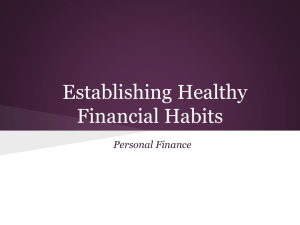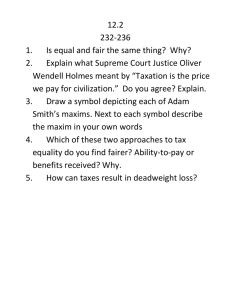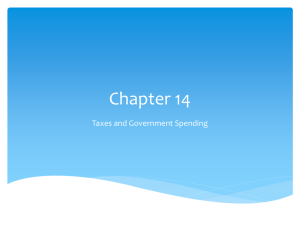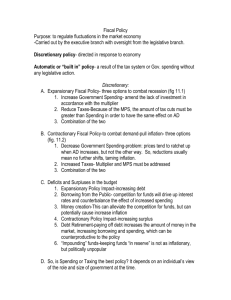taxes and fiscal policy
advertisement
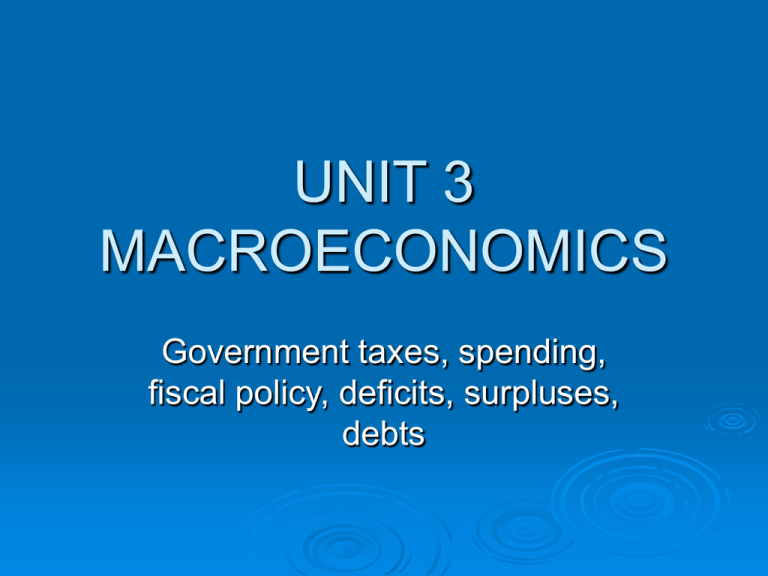
UNIT 3 MACROECONOMICS Government taxes, spending, fiscal policy, deficits, surpluses, debts TAX STRUCTURES Proportional tax- percentage of income paid in taxes is the same for all income levels Progressive tax- the percentage of income paid in taxes increases as income increases Regressive tax- percentage of income paid in taxes decreases as income increases CHARACTERISTICS OF A GOOD TAX Simplicity-rules should be easy to understand Efficiency-should be able to compute easily and inexpensively Certainty-people should know when they’re due, how much to pay, etc. Equity-should be fair TYPES OF TAXES Income tax- % of income Sales tax- % of a good’s price FICA taxes- fund Social Security and Medicare Property taxes- based on value of property Corporate income tax- % of a company’s profits Excise tax- tax on the sale or manufacture of a good Estate tax- tax on the total value of the money and property of a person who has died Gift tax- tax on money or property that one living person gives to another Tariffs- taxes on imported goods Incentive tax- tax to encourage or discourage a certain behavior GOVERNMENT SPENDING Mandatory spending- government spending on programs that are required by current law Interest on the national debt Entitlement programs- if people meet requirements they receive benefits Discretionary spending- government planners can make choices about spending National defense Education Foreign aid Scientific research Much more FISCAL POLICY The use of government spending and revenue collection to influence the economy Expansionary policies- lower taxes and higher spending to promote growth Contractionary/restrictive policieshigher taxes and lower spending to reduce economic growth LIMITS OF FISCAL POLICY Hard to change spending Predicting the future Delayed results Political pressures Coordinating policy with the states and the Federal Reserve’s monetary policy DEFICITS, SURPLUSES, AND THE NATIONAL DEBT Budget deficit- government spending exceeds tax collection Budget surplus- tax collection exceeds spending National debt- all the money the federal government owes to bondholders FISCAL POLICY OPTIONS Classical economics-the market should regulate itself Keynesian economics- the economy is made up of three sectors: individuals, businesses, and the government The government should intervene to make up for changes in the other two to move aggregate demand in the right direction Supply-side economics- focuses on moving aggregate supply to help the economy GOVERNMENT INVOLVEMENT IN THE ECONOMY Public good- a shared good or service for which it would be impractical to make consumers pay for individually and exclude nonpayers free rider- someone who would not pay for a good or service but gets the benefits of it if it were provided publicly Market failure- a situation where the market doesn’t distribute resources efficiently EXTERNALITIES Externality- an economic side effect that benefits or costs someone other than the one who produces or consumes the good EXTERNALITIES AND MARKET INEFFICIENCY Negative Externalities Automobile exhaust Cigarette smoking Barking dogs (loud pets) Loud stereos in an apartment building EXTERNALITIES AND MARKET INEFFICIENCY Positive Externalities Immunizations Restored historic buildings Research into new technologies POVERTY Poverty rate- % of people who live in households below the official poverty line Causes of poverty Lack of education Location Discrimination Economic shifts Changes in family structure ANTI-POVERTY PROGRAMS Welfare- economic aid to the poor Cash transfers- direct payments of money to poor people Temporary Assistance for Needy Families Social Security Unemployment benefits Worker’s compensation In-kind transfers- goods and services provided for free or reduced prices Food stamps Housing Legal services FORM 1040 Fill out the info at the top-use a spouse if you want to, dream spouse, etc. Don’t use real social security #, make it up 1-5. filing status Single Married jointly Married separately Head of household: married with children Widower: spouse deceased 6. exemptions Check box for you and for spouse List names of kids if any Add up total number of exemptions and put the number in the box 7. make up a salary for last year 8a. Make up interest from a bank account 9a. Make up dividends from stock investments 11. if you like, write down alimony received from previous spouse(s) 12. if you ran your own business, put the income you made from that 13. if you made money selling stocks, put it here 17. if you rented out real estate, put the amount you made here 18. if you got income from a farm, put it here 19. if you were unemployed for part of last year, put the amount you received here 22. add up lines 7-21 and put here 23. up to $250 in teacher expenses can be put here 26. if you spent money to move, put it here 31. if you paid alimony to a former spouse, put the amount here 33. if you were paying interest on a student loan, put it here 34. if you paid tuition and fees, put the amount here 36. add lines 23-35 and put here 37. line 22 minus line 36 Turn over the form and copy the amount on line 37 to line 38 40a. Write your standard deduction from the box on the left 41. line 38 minus line 40a 42. Put $10,000 43. put line 41 on line 43 also $10,000 less 44. using your income on line 43 and the tax table on the next slide, compute your tax and write it here 10% on income between $0 and $8,350 15% on the income between $8,350 and $33,950; plus $835 25% on the income between $33,950 and $82,250; plus $4,675 28% on the income between $82,250 and $171,550; plus $16,750 33% on the income between $171,550 and $372,950; plus $41,754 35% on the income over $372,950; plus $108,216 61. put ½ of line 43 71. recopy from line 61 72. if 71 is bigger than 60, 71-60; 0 if not true 75. if 60 is bigger than 71, 60-71; 0 if not true
